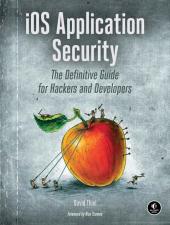Page 9: In the last paragraph,
In the absence of this API, developers have implemented a number of tricks to try detect jailbreaking themselves.
should instead be
In the absence of this API, developers have implemented a number of tricks to try to detect jailbreaking themselves.
Page 16: Listing 2-2 should include @end at the end of the listing.
Page 21: Listing 2-4, should include @end before
@implementation and again at the end of the listing.
Page 27: In the second paragraph,
The quickest way find out what data your application stores locally on an iOS device is to check out...
should instead be
The quickest way to find out what data your application stores locally on an iOS device is to check out...
Page 27:
~Library/Developer/CoreSimulator/Devices
should instead be
~/Library/Developer/CoreSimulator/Devices
Page 27:
~/data/Containers/Data/Application/
should instead be
/data/Containers/Data/Application/
Page 66: Under Listing 5-1, it reads,
To examine the variables of the current frame, you can use the frame
variable command, as shown in Listing ??.
but it should instead read
To examine the variables of the current frame, you can use the frame
variable command, as shown in Listing 5-2.
Page 83: port 666 should actually be port 1234
Page 86: In the last paragraph,
These values are in hexadecimal, though―a quick way to obtain the hex values is to execute the following in the Terminal…
should instead read
These values are in decimal, though―a quick way to obtain the hex values is to execute the following in the Terminal…
Page 93: "de.vi.c.e" should be “de.vi.ce.ip”
Page 96: “192.168.1.107” should be “de.vi.ce.ip”
Page 100: In the last line, “Intropsy” should be “Introspy”
Page 101: In the second line, “Cydia Substratey” should be “Cydia Substrate”
Page 112: In Table 7-1, NSURLCredentialPersistencePermanent is incorrectly listed twice. Please refer to the second entry.
Page 121:
In Listing 7-9, NSRULSessionConfiguration should be NSURLSessionConfiguration
Page 153: In the second paragraph,
(This is a bug in iOS that, as of iOS 8, has yet to be resolved.)
should instead read
(This is a bug in iOS that, as of iOS 9, has yet to be resolved.)
Page 185: In the last paragraph
I discuss encryption in more detail in Chapter 13), but here’s how you’d encrypt this particular sort of data.
should instead read
I discuss encryption in more detail in Chapter 13, but here’s how you’d encrypt this particular sort of data.
Page 241: In the last paragraph,
While HealthKit shows how to record steps, but there are more detailed
ways to get motion data to help guess exactly what kind of activity the user is
engaged in.
should instead read
While HealthKit shows how to record steps, there are more detailed
ways to get motion data to help guess exactly what kind of activity the user is
engaged in.

